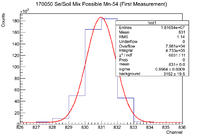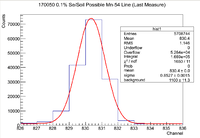Difference between revisions of "LB Manganese Work"
Jump to navigation
Jump to search
| Line 1: | Line 1: | ||
To observe Mn-54, attempt to find 834 keV (Chan 828.58) with an acceptable decay rate by checking the first and last measurements of Se/Soil (note that the Mn-54 line has a longer half life than Se-75). If the 834 keV line is not visible or decays faster than Se-75 (120 d vs. 312 d for Se-75 and Mn 54 respectively, then reject it as a possibility. I will check both the lowest and the highest concentration as they are upper and lower bounds. Note each of the following histograms are weighted by the mass of the soil. | To observe Mn-54, attempt to find 834 keV (Chan 828.58) with an acceptable decay rate by checking the first and last measurements of Se/Soil (note that the Mn-54 line has a longer half life than Se-75). If the 834 keV line is not visible or decays faster than Se-75 (120 d vs. 312 d for Se-75 and Mn 54 respectively, then reject it as a possibility. I will check both the lowest and the highest concentration as they are upper and lower bounds. Note each of the following histograms are weighted by the mass of the soil. | ||
| + | |||
| + | [[File:LB Possible Mn54 FirstMeasure.png|200px]] | ||
| + | |||
| + | [[File:LB Possible Mn54 LastMeasure.png|200px]] | ||
Revision as of 16:18, 24 July 2018
To observe Mn-54, attempt to find 834 keV (Chan 828.58) with an acceptable decay rate by checking the first and last measurements of Se/Soil (note that the Mn-54 line has a longer half life than Se-75). If the 834 keV line is not visible or decays faster than Se-75 (120 d vs. 312 d for Se-75 and Mn 54 respectively, then reject it as a possibility. I will check both the lowest and the highest concentration as they are upper and lower bounds. Note each of the following histograms are weighted by the mass of the soil.

